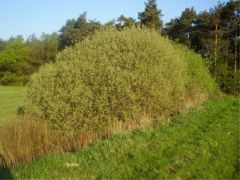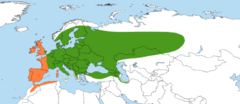Salix cinerea: Difference between revisions
No edit summary |
No edit summary |
||
| Line 1: | Line 1: | ||
{{SPlantbox | |||
|Min ht metric=cm | |||
|Temp Metric=°F | |||
|image=Upload.png | |||
|image_width=240 | |||
}} | |||
{{Inc| | |||
Salix cinerea, Linn. Large shrub or small tree, to 25 ft.: 1- and 2-year-old branchlets tomentose: stipules often persistent: lvs. obovate or elliptic, acute or rounded, narrowed or rounded at the base, irregularly serrate, pubescent on both sides, 1 1/2 – 2 1/2 in. long: catkins sessile, before the lvs.; staminate ovoid; filaments pilose, free; pistillate cylindric; ovary pubescent; style very short or wanting. April. Eu., N. Afr., W. and N. Asia. Var. oleifolia, Reichb. (var. angustifolia, Doll). Lvs. elliptic-lanceolate. | |||
}} | |||
{{Taxobox | {{Taxobox | ||
| color = lightgreen | | color = lightgreen | ||
Revision as of 10:12, 7 December 2009
| subsp. var. | ||||||||||||||||||||||||||||||||||||||||||||||||||||||||
|---|---|---|---|---|---|---|---|---|---|---|---|---|---|---|---|---|---|---|---|---|---|---|---|---|---|---|---|---|---|---|---|---|---|---|---|---|---|---|---|---|---|---|---|---|---|---|---|---|---|---|---|---|---|---|---|---|

|
|
| ||||||||||||||||||||||||||||||||||||||||||||||||||||||
| ||||||||||||||||||||||||||||||||||||||||||||||||||||||||
| Standard Cyclopedia of Horticulture |
|---|
|
Salix cinerea, Linn. Large shrub or small tree, to 25 ft.: 1- and 2-year-old branchlets tomentose: stipules often persistent: lvs. obovate or elliptic, acute or rounded, narrowed or rounded at the base, irregularly serrate, pubescent on both sides, 1 1/2 – 2 1/2 in. long: catkins sessile, before the lvs.; staminate ovoid; filaments pilose, free; pistillate cylindric; ovary pubescent; style very short or wanting. April. Eu., N. Afr., W. and N. Asia. Var. oleifolia, Reichb. (var. angustifolia, Doll). Lvs. elliptic-lanceolate.
|
| Salix cinerea {{{status}}} Fossil range: {{{fossil_range}}}
| ||||||||||||||||||||||||||||||||||||||||||||||||||||||||||||||||||
|---|---|---|---|---|---|---|---|---|---|---|---|---|---|---|---|---|---|---|---|---|---|---|---|---|---|---|---|---|---|---|---|---|---|---|---|---|---|---|---|---|---|---|---|---|---|---|---|---|---|---|---|---|---|---|---|---|---|---|---|---|---|---|---|---|---|---|
 Salix cinerea subsp. cinerea, Germany | ||||||||||||||||||||||||||||||||||||||||||||||||||||||||||||||||||
| Plant Info | ||||||||||||||||||||||||||||||||||||||||||||||||||||||||||||||||||
| ||||||||||||||||||||||||||||||||||||||||||||||||||||||||||||||||||
| Scientific classification | ||||||||||||||||||||||||||||||||||||||||||||||||||||||||||||||||||
| ||||||||||||||||||||||||||||||||||||||||||||||||||||||||||||||||||
| [[{{{diversity_link}}}|Diversity]] | ||||||||||||||||||||||||||||||||||||||||||||||||||||||||||||||||||
| {{{diversity}}} | ||||||||||||||||||||||||||||||||||||||||||||||||||||||||||||||||||
| Binomial name | ||||||||||||||||||||||||||||||||||||||||||||||||||||||||||||||||||
| Salix cinerea L. | ||||||||||||||||||||||||||||||||||||||||||||||||||||||||||||||||||
| Trinomial name | ||||||||||||||||||||||||||||||||||||||||||||||||||||||||||||||||||
| {{{trinomial}}} | ||||||||||||||||||||||||||||||||||||||||||||||||||||||||||||||||||
| Type Species | ||||||||||||||||||||||||||||||||||||||||||||||||||||||||||||||||||
| {{{type_species}}} | ||||||||||||||||||||||||||||||||||||||||||||||||||||||||||||||||||
| {{{subdivision_ranks}}} | ||||||||||||||||||||||||||||||||||||||||||||||||||||||||||||||||||
 Green: Salix cinerea subsp. cinerea Orange: Salix cinerea subsp. oleifolia. | ||||||||||||||||||||||||||||||||||||||||||||||||||||||||||||||||||
| Synonyms | ||||||||||||||||||||||||||||||||||||||||||||||||||||||||||||||||||
| {{{synonyms}}} |
Salix cinerea (Grey Willow; also occasionally Grey Sallow) is a species of willow native to Europe and western Asia.[1][2]
It is a deciduous shrub or small tree growing to 4-15 m high. The leaves are spirally arranged, 2–9 cm long and 1–3 cm broad (exceptionally up to 16 cm long and 5 cm broad), green above, hairy below, with a crenate margin. The flowers are produced in early spring in catkins 2–5 cm long; it is dioecious with male and female catkins on separate plants. The male catkins are silvery at first, turning yellow when the pollen is released; the female catkins are greenish-grey, maturing in early summer to release the numerous tiny seeds embedded in white cottony down which assists wind dispersal.[1][2]
There are two subspecies:[1][2]
- Salix cinerea subsp. cinerea. Central and eastern Europe, western Asia. Shrub to 4–6 m (rarely 10 m) tall, with smooth bark. Leaves densely hairy below with pale yellow-grey hairs; stipules large, persistent until autumn.
- Salix cinerea subsp. oleifolia (Sm.) Macreight (syn. S. atrocinerea Brot.). Western Europe, northwest Africa. Shrub or tree to 10–15 m tall, with furrowed bark. Leaves thinly hairy below with dark red-brown hairs; stipules small, early deciduous.
There is some overlap in the distributions (not indicated in the map, right), with both occurring in a broad band north to south through France, and scattered specimens of subsp. cinerea west to Ireland, western France, and Morocco; scattered specimens of subsp. oleifolia occur east to the Netherlands. Specimens of subsp. oleifolia in southern Scandinavia are planted or naturalised, not native. Intermediate specimens also occur.[1][2]
Ecology
It usually grows in wetlands. The two subspecies differ slightly in requirements, with subsp. cinerea generally restricted to basic marshland and fen habitats, while subsp. oleifolia is less demanding, occurring in both basic marshes and acidic bogs and streamsides.[1]
References
Template:Reflist Template:Commons
- ↑ 1.0 1.1 1.2 1.3 1.4 Meikle, R. D. (1984). Willows and Poplars of Great Britain and Ireland. BSBI Handbook No. 4. ISBN 0-901158-07-0.
- ↑ 2.0 2.1 2.2 2.3 Christensen, K. I., & Nielsen, H. (1992). Rust-pil (Salix cinerea subsp. oleifolia) - en overset pil i Danmark og Skandinavien. Dansk Dendrologisk Årsskrift 10: 5-17.